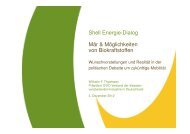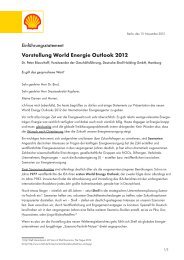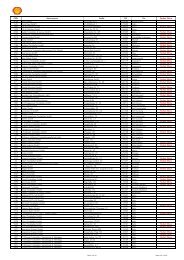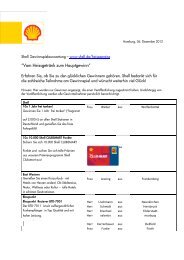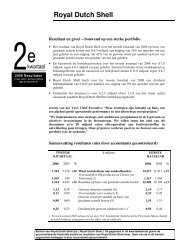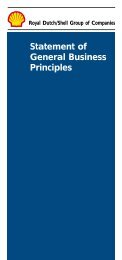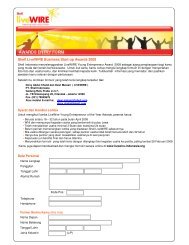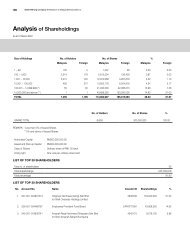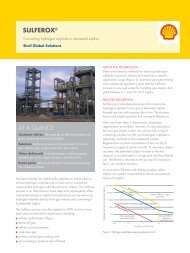Communicating Business Contributions to the Millennium - Shell
Communicating Business Contributions to the Millennium - Shell
Communicating Business Contributions to the Millennium - Shell
You also want an ePaper? Increase the reach of your titles
YUMPU automatically turns print PDFs into web optimized ePapers that Google loves.
<strong>Communicating</strong> <strong>Business</strong> <strong>Contributions</strong> <strong>to</strong> <strong>the</strong><br />
<strong>Millennium</strong> Development Goals<br />
November 2004<br />
Summary<br />
To help show businesses how <strong>the</strong>y might contribute <strong>to</strong> <strong>the</strong> achievement of <strong>the</strong> <strong>Millennium</strong><br />
Development Goals, UNDP and IBLF created a document titled “<strong>Business</strong> and <strong>the</strong> <strong>Millennium</strong><br />
Development Goals: A Framework for Action..” GRI has built upon this document by suggesting<br />
indica<strong>to</strong>rs from <strong>the</strong> Sustainability Reporting Guidelines that might be paired with <strong>the</strong> business<br />
activities suggested by UNDP and IBLF so that businesses can better measure and communicate<br />
<strong>the</strong>ir contributions <strong>to</strong>wards <strong>the</strong>se important goals.<br />
Contact<br />
Leontien Plugge<br />
Global Reporting Initiative<br />
+31-20-531-0000<br />
plugge@globalreporting.org<br />
Sponsor<br />
GRI is grateful <strong>to</strong> <strong>the</strong> Royal Ministry of Foreign Affairs, Norway, for <strong>the</strong>ir support of this work.
<strong>Communicating</strong> <strong>Business</strong> <strong>Contributions</strong> <strong>to</strong> <strong>the</strong><br />
<strong>Millennium</strong> Development Goals<br />
What are <strong>the</strong> <strong>Millennium</strong> Development Goals (MDGs)?<br />
www.un.org/millenniumgoals/<br />
The MDG’s were adopted at <strong>the</strong> United Nations <strong>Millennium</strong> Summit in September 2002<br />
by <strong>the</strong> Heads of Government and State of all UN member states. While <strong>the</strong> goals are<br />
primarily addressed <strong>to</strong> governments, it is recognised that <strong>the</strong>ir achievement will require a<br />
partnership between government and all sec<strong>to</strong>rs of civil society. There are eight goals,<br />
each with a number of associated targets for achievement by 2015.<br />
The MDGs are highly significant <strong>to</strong> sustainable<br />
development for two reasons. First, <strong>the</strong>y address social,<br />
economic and environmental dimensions of<br />
development, and prioritise some of humankind’s<br />
greatest challenges in <strong>the</strong> 21 st Century. These include<br />
reducing poverty and hunger; improving education,<br />
gender equality and health; and ensuring environmental<br />
sustainability. Second, <strong>the</strong>y reflect a broad official<br />
consensus on clear, measurable and time-bound goals<br />
for addressing <strong>the</strong>se challenges.<br />
A progress report issued in 2004 which evaluated efforts <strong>to</strong> attain <strong>the</strong> MDGs concluded<br />
that while advances were being made in some areas, overall “<strong>the</strong> world was not<br />
optimising its performance.” Since a high-level review is <strong>to</strong> be conducted in 2005, it is<br />
expected that governments will be intensifying efforts in <strong>the</strong> coming period <strong>to</strong> put<br />
<strong>the</strong>mselves on track <strong>to</strong> meet <strong>the</strong> goals on schedule. This will undoubtedly require<br />
intensified partnerships with <strong>the</strong> private sec<strong>to</strong>r.<br />
What is <strong>the</strong> businesses case for involvement in <strong>the</strong> MDGs?<br />
“Just as <strong>the</strong> private sec<strong>to</strong>r is critical <strong>to</strong> <strong>the</strong><br />
future of <strong>the</strong> developing world, <strong>the</strong> developing<br />
world is critical <strong>to</strong> <strong>the</strong> future of big business.<br />
Four out of five consumers live <strong>the</strong>re.”<br />
United Nations Development Programme<br />
“Companies must make a vital<br />
and increased contribution <strong>to</strong><br />
key targets set by governments<br />
on broad issues including<br />
poverty, equality and <strong>the</strong><br />
environment.”<br />
Sir Mark Moody-Stuart<br />
Governments and civil society worldwide are<br />
demanding more transparency and<br />
accountability from <strong>the</strong> corporate sec<strong>to</strong>r about<br />
<strong>the</strong>ir impacts on <strong>the</strong> economic, environmental<br />
and social spheres in which <strong>the</strong>y operate or<br />
influence. Many companies are demonstrating<br />
best practice by voluntarily taking a closer look<br />
at <strong>the</strong> role <strong>the</strong>y play, and how <strong>the</strong>y might begin<br />
<strong>to</strong> contribute - through <strong>the</strong>ir core business operations - <strong>to</strong> <strong>the</strong> targets outlined in <strong>the</strong> MDGs.<br />
That said, <strong>the</strong> question remains as <strong>to</strong> whe<strong>the</strong>r or not <strong>the</strong>re is a strong business case beyond <strong>the</strong><br />
argument that it is <strong>the</strong> “right thing <strong>to</strong> do.” The United Nations Development Programme (UNDP)<br />
and <strong>the</strong> Prince of Wales International <strong>Business</strong> Leaders Forum (IBLF) 1 presented compelling<br />
1 Jane Nelson and Dave Prescott. <strong>Business</strong> and <strong>the</strong> <strong>Millennium</strong> Development Goals: A Framework for<br />
Action. The International <strong>Business</strong> Leaders Forum, 2003.
evidence in a recent briefing that <strong>the</strong>re is a strong case for businesses <strong>to</strong> contribute <strong>to</strong> <strong>the</strong> MDGs<br />
for <strong>the</strong> following three reasons:<br />
• Investing in a sound business environment: <strong>Business</strong> works best when operating in<br />
stable and secure societies. Benefits include access <strong>to</strong> a healthy and competent workforce,<br />
prosperous consumers and inves<strong>to</strong>rs, and <strong>the</strong> existence of open, rule-based predictive,<br />
non-discrimina<strong>to</strong>ry trading and financial systems.<br />
• Managing direct costs and risks: Challenges like environmental degradation, disease,<br />
conflict and inadequate heath and education systems can result in increased costs<br />
associated with operational aspects, raw materials, personnel, security, and insurance.<br />
Companies that understand <strong>the</strong>se litigation, market and reputational risks will choose <strong>to</strong><br />
actively manage <strong>the</strong>m <strong>to</strong> reduce risks and enhance efficiency and productivity.<br />
• Harnessing new business opportunities:<br />
Developing countries, with large<br />
populations and untapped or unexplored<br />
resources, present <strong>the</strong> greatest new market<br />
opportunities available for business <strong>to</strong>day.<br />
For entrepreneurial companies, achievement<br />
of <strong>the</strong> MDGs means access <strong>to</strong> greater<br />
opportunities around innovation, value<br />
creation and competitiveness.<br />
“Helping <strong>to</strong> achieve <strong>the</strong> MDG’s is not only<br />
a matter of corporate social responsibility,<br />
embedded in compliance, risk management<br />
and philanthropy, but also a matter of<br />
corporate social opportunity, embedded in<br />
innovation, value creation and<br />
competitiveness.”<br />
Jane Nelson and David Prescott<br />
The main responsibility for <strong>the</strong> achievement of <strong>the</strong> MDG’s lies with governments, however, it is<br />
in business’ best interest <strong>to</strong> play a vital and constructive role in achieving <strong>the</strong> MDG’s. One of <strong>the</strong><br />
greatest challenges associated with sustainable development is <strong>to</strong> create linkages between <strong>the</strong><br />
agendas of nations, private sec<strong>to</strong>r, public agencies, and civil society at transnational, national and<br />
sub-national levels. Commitment <strong>to</strong> a common set of goals is a step in <strong>the</strong> right direction.<br />
How can business take practical actions <strong>to</strong> achieve <strong>the</strong> MDG’s?<br />
www.undp.org/business/docs/mdg_business.pdf<br />
At first glance, <strong>the</strong> MDGs – written by and for governments in <strong>the</strong> main - may not resonate with<br />
many business people. Some goals have very direct implications for business, o<strong>the</strong>rs relate more<br />
broadly <strong>to</strong> <strong>the</strong> enabling framework and policy environment in which <strong>the</strong> company operates.<br />
As mentioned above, UNDP in co-operation with <strong>the</strong> IBLF published a briefing called <strong>Business</strong><br />
and <strong>Millennium</strong> Development Goals: A Framework for Action on how companies and business<br />
coalitions can work with <strong>the</strong> UN system, governments, and civil society organisations <strong>to</strong> help<br />
achieve <strong>the</strong> MDG’s. This briefing translates <strong>the</strong> MDG’s in<strong>to</strong> business language and suggests<br />
concrete actions.<br />
Although not all MDGs will be relevant <strong>to</strong> all industry sec<strong>to</strong>rs and companies, <strong>the</strong> Framework<br />
for Action report provides some concrete suggestions for action organized under <strong>the</strong> following<br />
categories:<br />
• Core business activities. Action that can be taken in <strong>the</strong> workplace, <strong>the</strong> marketplace and<br />
within supply chains.<br />
• Social investment and philanthropic activities. Action that can be taken by harnessing<br />
core competencies <strong>to</strong> help streng<strong>the</strong>n communities.
• Public policy dialogue and advocacy activities. Action that can be taken at <strong>the</strong><br />
individual and collective level <strong>to</strong> influence systemic change.<br />
How can businesses measure and report <strong>the</strong> results of <strong>the</strong>ir actions?<br />
In this document, GRI has taken a close look at <strong>the</strong> activities suggested in UNDP and IBLF’s A<br />
Framework for Action and presented a collection of indica<strong>to</strong>rs from <strong>the</strong> Sustainability Reporting<br />
Guidelines that may help companies report on <strong>the</strong>ir progress. UNDP and IBLF suggest actions<br />
businesses can take that are core business activities - <strong>the</strong>se are actions that reflect <strong>the</strong> core<br />
competencies of companies, can help create new markets in developing countries, and may have<br />
long lasting positive affects. A second category of business activities suggested by UNDP and<br />
IBLF fall under social investment and philanthropic activities. Indica<strong>to</strong>rs are suggested for <strong>the</strong><br />
activities suggested under both categories. See <strong>the</strong> figure below for an illustration on how <strong>the</strong>se<br />
three initiatives relate and are presented in <strong>the</strong> next section of this document.<br />
MDG goal 1<br />
-target 1<br />
-target 2<br />
As agreed by UN<br />
member states<br />
Core business actions:<br />
-suggestion 1<br />
-suggestion 2<br />
Social investment and<br />
philanthropic<br />
activities:<br />
-suggestion 1<br />
-suggestion 2<br />
As found in UNDP and IBLF’s<br />
Framework for Action<br />
GRI indica<strong>to</strong>rs:<br />
-list of suggested<br />
indica<strong>to</strong>rs that<br />
reflect business<br />
actions suggested.<br />
GRI indica<strong>to</strong>rs:<br />
-list of suggested<br />
indica<strong>to</strong>rs that<br />
reflect philanthropic<br />
actions suggested.<br />
As found in GRI’s<br />
Sustainability<br />
Reporting Guidelines<br />
How does reporting bring value <strong>to</strong> business activities?<br />
At <strong>the</strong> same time <strong>the</strong>re is a strong demand for companies <strong>to</strong> be responsible and accountable for<br />
<strong>the</strong>ir economic, social and environmental impacts everywhere <strong>the</strong>y operate, i.e. <strong>to</strong> certify and<br />
report on <strong>the</strong>ir practices. As governments and civil society begin <strong>to</strong> quantify progress against <strong>the</strong><br />
MDGs, <strong>the</strong>y will be looking <strong>to</strong> quantify <strong>the</strong> business contribution.<br />
Today’s strategic and operational complexities require a continual dialogue with inves<strong>to</strong>rs,<br />
cus<strong>to</strong>mers, advocates, suppliers, and employees. Reporting is a key ingredient <strong>to</strong> building,<br />
sustaining, and continually refining <strong>the</strong>se stakeholder relationships.
Linking business action and reporting <strong>to</strong> <strong>the</strong> MDGs.<br />
1<br />
MDG Goal 1: Eradicate extreme poverty and hunger<br />
Target 1: Halve between 1990 and 2015, <strong>the</strong> proportion of people whose income<br />
is less than one dollar a day.<br />
Target 2: Halve, between 1990 and 2015, <strong>the</strong> proportion of people who suffer<br />
from hunger<br />
Core business activities<br />
1. Providing affordable products and services – can <strong>the</strong> company develop new product and<br />
service offerings that reach poor communities or extend <strong>the</strong> distribution outreach of existing<br />
products? How can companies increase access <strong>to</strong> <strong>the</strong>ir products in an economically viable<br />
manner? How can companies rethink conventional wisdom about capital efficiency, product<br />
development, distribution, business models and joint ventures <strong>to</strong> make a profit by serving <strong>the</strong><br />
needs of <strong>the</strong> poor?<br />
2. Building local business linkages and employment opportunities – Can <strong>the</strong> company find new<br />
ways <strong>to</strong> open up its distribution, procurement and recruitment channels <strong>to</strong> excluded groups? Are<br />
<strong>the</strong>re opportunities <strong>to</strong> build linkages with local small, medium and micro-enterprises or develop<br />
<strong>the</strong> skills and employability of local people? Large companies and business associations can play<br />
a key role in: building supplier relationships and o<strong>the</strong>r business linkages with SMMEs; supplying<br />
credit, equity, risk insurance and o<strong>the</strong>r financing products, especially in <strong>the</strong> case of financial<br />
institutions; supporting <strong>the</strong> transfer of appropriate product and process technologies; and<br />
providing training, men<strong>to</strong>ring, capacity building and information sharing programmes.<br />
GRI indica<strong>to</strong>rs that can be used <strong>to</strong> report on <strong>the</strong>se actions:<br />
EC5: Total payroll and benefits (including wages, pension, o<strong>the</strong>r benefits, and redundancy payments) broken down by country or<br />
region<br />
EC8: Total sum of taxes of all types paid broken down by country.<br />
EC11: Supplier breakdown by organization and country.<br />
LA1: Breakdown of workforce, where possible, by region / country, status, employment type, and by employment contract. Also<br />
identify workforce retained in conjunction with o<strong>the</strong>r employers segmented by region / country.<br />
LA2: Net employment creation and average turnover segmented by region / country.<br />
LA12: Employee benefits beyond those legally mandated.<br />
PR1: Description of policy for preserving cus<strong>to</strong>mer health and safety during use of products and services, and extent <strong>to</strong> which this<br />
policy is visibly stated and applied, as well as description of procedures / programmes <strong>to</strong> address this issue, including moni<strong>to</strong>ring<br />
systems and results of moni<strong>to</strong>ring.<br />
GRI indica<strong>to</strong>rs that depending on <strong>the</strong> action your company chooses may be of use:<br />
LA 9: Average hours of training per year per employee by category of employee.<br />
LA17: Specific policies and programmes for skills management or lifelong learning.<br />
LA10: Description of equal opportunities policies or programmes, as well as moni<strong>to</strong>ring systems <strong>to</strong> ensure compliance and results<br />
of moni<strong>to</strong>ring<br />
HR1: Description of policies, guidelines, corporate structure, and procedures <strong>to</strong> deal with all aspects of human rights relevant <strong>to</strong><br />
operations, including moni<strong>to</strong>ring mechanisms and results.<br />
HR3: Description of policies and procedures <strong>to</strong> evaluate and address human rights performance within <strong>the</strong> supply chain and<br />
contrac<strong>to</strong>rs, including moni<strong>to</strong>ring systems and results of moni<strong>to</strong>ring<br />
HR14: Share of operating revenues from <strong>the</strong> area of operations that are redistributed <strong>to</strong> local communities.
Social Investment and Philanthropy<br />
1. Invest in social entrepreneurs – Can <strong>the</strong> company support NGOs or community leaders who<br />
are targeting some of <strong>the</strong> key causes of poverty?<br />
2. Build local capacity – Instead of one-off donations, how can <strong>the</strong> company help build <strong>the</strong><br />
sustainability, skills and resilience of local NGOs and community groups over a longer period of<br />
time?<br />
GRI indica<strong>to</strong>rs that can be used <strong>to</strong> report on <strong>the</strong>se actions:<br />
EC10: Donations <strong>to</strong> community, civil society, and o<strong>the</strong>r groups broken down in terms of cash and in-kind donations per type of<br />
group.<br />
EC13: The organization’s indirect economic impact<br />
EC12: Total spent on non-core business infrastructure development.<br />
SO1: Description of policies <strong>to</strong> manage impacts on communities in areas affected by activities, as well as description of procedures/<br />
programmes <strong>to</strong> address this issue, including moni<strong>to</strong>ring systems and results of moni<strong>to</strong>ring.<br />
2<br />
MDG Goal 2 : Achieve universal primary education<br />
Target 3: Ensure that, by 2015, children everywhere, boys and girls alike, will be<br />
able <strong>to</strong> complete a full course of primary schooling.<br />
Core business activities<br />
1. Tackle child labour – Companies with global supply chains and contrac<strong>to</strong>rs in developing<br />
countries are playing an increasing role in tackling child labour along <strong>the</strong>se supply chains. Given<br />
<strong>the</strong> fact that children usually go <strong>to</strong> work because <strong>the</strong>ir families are poor and cannot afford <strong>to</strong> send<br />
<strong>the</strong>m <strong>to</strong> school, such initiatives are often accompanied by efforts <strong>to</strong> support <strong>the</strong> education of <strong>the</strong>se<br />
children.<br />
2. Deliver education services – In certain situations private sec<strong>to</strong>r entities can work with <strong>the</strong><br />
public sec<strong>to</strong>r or operate independently. The most appropriate balance of public and private<br />
delivery of education and education-related support services, however, continues <strong>to</strong> be an area of<br />
debate.<br />
3. Harness technology for education – Information, communication and education-based<br />
companies can play a role in developing culturally relevant education materials and innovative<br />
learning methodologies and in supporting <strong>the</strong> use of information and communications<br />
technologies in schools.<br />
GRI indica<strong>to</strong>rs that can be used <strong>to</strong> report on <strong>the</strong>se actions:<br />
HR3: description of policies and procedures <strong>to</strong> evaluate and address human rights performance within <strong>the</strong> supply chain and<br />
contrac<strong>to</strong>rs, including moni<strong>to</strong>ring systems and results of moni<strong>to</strong>ring.<br />
HR6: Description of policy excluding child labour as defined by <strong>the</strong> ILO Convention 138 and extent <strong>to</strong> which this policy is visibly<br />
stated and applied, as well as description of procedures/ programmes <strong>to</strong> address this issue, including moni<strong>to</strong>ring systems and results<br />
of moni<strong>to</strong>ring. See GRI Child Labour Pro<strong>to</strong>col<br />
GRI indica<strong>to</strong>rs that depending on <strong>the</strong> action your company chooses may be of use:<br />
EC8: Total sum of taxes of all types paid broken down by country<br />
HR7: Description of policy <strong>to</strong> prevent forced and compulsory labour and extent <strong>to</strong> which this policy is visibly stated and applied as<br />
well as description of procedures/programmes <strong>to</strong> address this issue, including moni<strong>to</strong>ring systems and results of moni<strong>to</strong>ring.<br />
See ILO Convention No. 29, Article 2.
Social Investment and Philanthropy<br />
1. Facilitate <strong>the</strong> education of employees’ children – Companies that are major inves<strong>to</strong>rs in<br />
developing countries can support <strong>the</strong> education of <strong>the</strong>ir employees’ families at different levels,<br />
from supporting on-site or local community schools <strong>to</strong> providing scholarships for tertiary<br />
education.<br />
2. Invest in local schools or support <strong>the</strong> work of education NGOs – Companies can do this<br />
through donations i.e. financial contributions and product donations, such as books, technology<br />
and equipment, ei<strong>the</strong>r directly <strong>to</strong> schools or <strong>to</strong> NGOs and o<strong>the</strong>r intermediaries active in <strong>the</strong><br />
education field. They can also support employee engagement in schools, for example men<strong>to</strong>ring<br />
students, teaching young people about <strong>the</strong> world of work and sharing management skills with<br />
school administra<strong>to</strong>rs.<br />
GRI indica<strong>to</strong>rs that can be used <strong>to</strong> report on <strong>the</strong>se actions:<br />
EC10: Donations <strong>to</strong> community, civil society, and o<strong>the</strong>r groups broken down in terms of cash and in-kind donations per type of<br />
group.<br />
EC12: Total spent on non-core business infrastructure development.<br />
SO1: Description of policies <strong>to</strong> manage impacts on communities in areas affected by activities, as well as description of procedures/<br />
programmes <strong>to</strong> address this issue, including moni<strong>to</strong>ring systems and results of moni<strong>to</strong>ring.<br />
3<br />
MDG Goal 3 : Promote gender equality and empower women<br />
Target 4: Eliminate gender disparity in primary and secondary education<br />
preferably by 2005 and <strong>to</strong> all levels of education no later than 2015.<br />
Core business activities<br />
1. Streng<strong>the</strong>ning women’s economic capacity as entrepreneurs, employees and producers – By<br />
employing more women and supporting workplace diversity programmes, or developing business<br />
linkages or credit programmes with women entrepreneurs, companies can help <strong>the</strong>m <strong>to</strong> hone <strong>the</strong>ir<br />
technical and marketing skills, streng<strong>the</strong>n <strong>the</strong>ir negotiation and bargaining tactics, foster <strong>the</strong>ir<br />
access <strong>to</strong> and influence over new technologies, build networks and business associations and<br />
identify new market opportunities, both locally and globally.<br />
2. Eliminating workplace violence against women – Companies that employ large numbers of<br />
women, ei<strong>the</strong>r directly or along <strong>the</strong>ir global supply chain, have a role in tackling sexual<br />
harassment and o<strong>the</strong>r forms of workplace violence or mistreatment of female workers. Tourism<br />
and entertainment companies have a role in addressing sexual exploitation and trafficking of<br />
women.
4<br />
GRI indica<strong>to</strong>rs that can be used <strong>to</strong> report on <strong>the</strong>se actions:<br />
HR2: Evidence of consideration of human rights impacts as part of investment and procurement decisions, including selection of<br />
suppliers/contrac<strong>to</strong>rs.<br />
HR4: Description of global policy and procedures/programmes preventing all forms of discrimination in operations, including<br />
moni<strong>to</strong>ring systems and results of moni<strong>to</strong>ring.<br />
LA10: Description of equal opportunity policies or programmes, as well as moni<strong>to</strong>ring systems <strong>to</strong> ensure compliance and results of<br />
moni<strong>to</strong>ring.<br />
LA11: Composition of senior management and corporate governance bodies (including <strong>the</strong> board of direc<strong>to</strong>rs), including<br />
female/male ratio and o<strong>the</strong>r indica<strong>to</strong>rs of diversity as culturally appropriate.<br />
GRI indica<strong>to</strong>rs that depending on <strong>the</strong> action your company chooses may be of use:<br />
LA1: Breakdown of workforce, where possible, by region/country, status (employee/non-employee), employment type (full<br />
time/part time), and by employment contract (indefinite or permanent/fixed term or temporary). Also identify workforce retained in<br />
conjunction with o<strong>the</strong>r employers (temporary agency workers or workers in co-employment relationships), segmented by<br />
region/country.<br />
LA 9: Average hours of training per year per employee by category of employee.<br />
LA17: Specific policies and programmes for skills management or lifelong learning.<br />
LA16<br />
HR7: Description of policy <strong>to</strong> prevent forced and compulsory labour and extent <strong>to</strong> which this policy is visibly stated and applied as<br />
well as description of procedures/programmes <strong>to</strong> address this issue, including moni<strong>to</strong>ring systems and results of moni<strong>to</strong>ring.<br />
See ILO Convention No. 29, Article 2.<br />
HR12: Description of policies, guidelines, and procedures <strong>to</strong> address <strong>the</strong> needs of indigenous people.<br />
Social Investment and Philanthropy<br />
1. Support women’s issues – ei<strong>the</strong>r directly or through NGOs that focus on <strong>the</strong>se issues.<br />
2. Invest in women’s leadership development beyond <strong>the</strong> company’s own operations – support<br />
women’s capacity building and networking programmes; awards and recognition initiatives; and<br />
targeted efforts <strong>to</strong> place women in specific leadership positions for example on government task<br />
forces and delegations, company boards, peace negotiation teams and in senior roles in<br />
international organizations.<br />
GRI indica<strong>to</strong>rs that can be used <strong>to</strong> report on <strong>the</strong>se actions:<br />
EC10: Donations <strong>to</strong> community, civil society, and o<strong>the</strong>r groups broken down in terms of cash and in-kind donations per type of<br />
group.<br />
EC12: Total spent on non-core business infrastructure development.<br />
SO1: Description of policies <strong>to</strong> manage impacts on communities in areas affected by activities, as well as description of procedures/<br />
programmes <strong>to</strong> address this issue, including moni<strong>to</strong>ring systems and results of moni<strong>to</strong>ring.<br />
MDG Goal 4 : Reduce child mortality<br />
Target 5: Reduce by two thirds, between 1990 and 2015, <strong>the</strong> under-five mortality rate.<br />
Core business activities<br />
1. Provide affordable products and services – increase access of poorer families <strong>to</strong> basic<br />
medicines, nutritionally good food, clean water and consumer products that help <strong>to</strong> increase<br />
household hygiene.
GRI indica<strong>to</strong>rs that depending on <strong>the</strong> action your company chooses may be of use:<br />
LA12: employee benefits beyond those legally mandated. (e.g., contributions <strong>to</strong> health care, disability, maternity, education, and<br />
retirement).<br />
PR1: Description of policy for preserving cus<strong>to</strong>mer health and safety during use of products and services, and extent <strong>to</strong> which this<br />
policy is visibly stated and applied, as well as description of procedures / programmes <strong>to</strong> address this issue, including moni<strong>to</strong>ring<br />
systems and results of moni<strong>to</strong>ring.<br />
LA8: Description of policies or programmes (for <strong>the</strong> workplace and beyond) on HIV/AIDS.<br />
See GRI HIV/AIDS Resource Document<br />
Social Investment and Philanthropy<br />
1. Support children’s NGOs and awareness raising projects – companies can support education<br />
and community projects <strong>to</strong> promote basic hygiene and sanitation, improve nutrition, and ensure<br />
access <strong>to</strong> basic medicines <strong>to</strong> minimize <strong>the</strong> core causes of childhood mortality.<br />
2. Support programmes for AIDS Orphans<br />
GRI indica<strong>to</strong>rs that can be used <strong>to</strong> report on <strong>the</strong>se actions:<br />
EC10: Donations <strong>to</strong> community, civil society, and o<strong>the</strong>r groups broken down in terms of cash and in-kind donations per type of<br />
group.<br />
EC12: Total spent on non-core business infrastructure development.<br />
SO1: Description of policies <strong>to</strong> manage impacts on communities in areas affected by activities, as well as description of procedures/<br />
programmes <strong>to</strong> address this issue, including moni<strong>to</strong>ring systems and results of moni<strong>to</strong>ring.<br />
5<br />
Core business activities<br />
MDG Goal 5 : Improve maternal health<br />
Target 6: Reduce by three-quarters, between 1990 and 2015, <strong>the</strong> maternal<br />
mortality rate<br />
1. Provide affordable products and services – Pharmaceutical and o<strong>the</strong>r healthcare companies, or<br />
those with large numbers of female employees, have a particularly important role <strong>to</strong> play in <strong>the</strong><br />
provision, ei<strong>the</strong>r commercially or on a donation basis, of reproductive health services and<br />
products.<br />
2. Improve working conditions and occupational health for women – one of <strong>the</strong> most pressing<br />
issues faced by women workers in developing countries is <strong>the</strong> need for more information,<br />
including different methods of contraception, sexually transmitted diseases and nutritional issues.<br />
GRI indica<strong>to</strong>rs that depending on <strong>the</strong> action your company chooses may be of use:<br />
LA12: employee benefits beyond those legally mandated. (e.g., contributions <strong>to</strong> health care, disability, maternity, education, and<br />
retirement).<br />
PR1: Description of policy for preserving cus<strong>to</strong>mer health and safety during use of products and services, and extent <strong>to</strong> which this<br />
policy is visibly stated and applied, as well as description of procedures / programmes <strong>to</strong> address this issue, including moni<strong>to</strong>ring<br />
systems and results of moni<strong>to</strong>ring.<br />
LA5: Practices on recording and notification of occupational accidents and diseases, and how <strong>the</strong>y relate <strong>to</strong> <strong>the</strong> ILO Code of<br />
Practice on Recording and Notification of Occupational Accidents and Diseases.<br />
LA14: Evidence of substantial compliance with <strong>the</strong> ILO Guidelines for Occupational Health Management Systems.
Social Investment and Philanthropy<br />
1. Support women’s NGOs and community health services<br />
2. Combat stigmatization – because in many developing countries <strong>the</strong>re can be a range of cultural<br />
and religious fac<strong>to</strong>rs which hinder open discussion and proactive action on reproductive health<br />
issues, companies can look <strong>to</strong> external networks and civil society organizations which offer<br />
support <strong>to</strong> female workers on <strong>the</strong>se issues.<br />
GRI indica<strong>to</strong>rs that can be used <strong>to</strong> report on <strong>the</strong>se actions:<br />
SO1: Description of policies <strong>to</strong> manage impacts on communities in areas affected by activities, as well as description of procedures/<br />
programmes <strong>to</strong> address this issue, including moni<strong>to</strong>ring systems and results of moni<strong>to</strong>ring.<br />
EC10: Donations <strong>to</strong> community, civil society, and o<strong>the</strong>r groups broken down in terms of cash and in-kind donations per type of<br />
group.<br />
EC12: Total spent on non-core business infrastructure development.<br />
HR4: Description of global policy and procedures/programmes preventing all forms of discrimination in operations, including<br />
moni<strong>to</strong>ring systems and results of moni<strong>to</strong>ring.<br />
6<br />
Core business activities<br />
MDG Goal 6 : Combat HIV/AIDS, malaria and o<strong>the</strong>r diseases<br />
Target 7: Have halted by 2015, and begun <strong>to</strong> reverse, <strong>the</strong> spread of HIV/AIDS<br />
Target 8: Have halted by 2015, and begun <strong>to</strong> reverse, <strong>the</strong> incidence of malaria<br />
and o<strong>the</strong>r major diseases<br />
1. Provide affordable products and services – Promoting health and preventing disease are<br />
obviously of particular relevance and responsibility for <strong>the</strong> pharmaceutical and healthcare sec<strong>to</strong>r.<br />
Some of <strong>the</strong> core business issues <strong>to</strong> be addressed include pricing strategies for HIV/AIDS drugs<br />
and o<strong>the</strong>r essential medicines in poor countries, product development and research priorities,<br />
patent protection and intellectual property rights, and patient rights.<br />
2. Implement workplace HIV/AIDS programmes focused on education, prevention, treatment and<br />
care.<br />
GRI indica<strong>to</strong>rs that can be used <strong>to</strong> report on <strong>the</strong>se actions:<br />
LA8: Description of policies or programmes (for <strong>the</strong> workplace and beyond) on HIV/AIDS.<br />
See GRI HIV/AIDS Resource Document<br />
LA6: Description of formal joint health and safety committees<br />
comprising management and worker representatives and proportion<br />
of workforce covered by any such committees.<br />
LA12: Employee benefits beyond those legally mandated.<br />
Social Investment and Philanthropy<br />
1. Provide product donations – donate products through corporate foundations, emergency relief<br />
and o<strong>the</strong>r social investment programmes.<br />
2. Support HIV/AIDS and o<strong>the</strong>r medical funds, NGOs or research institutes and AIDS orphans<br />
projects.
GRI indica<strong>to</strong>rs that can be used <strong>to</strong> report on <strong>the</strong>se actions:<br />
EC10: Donations <strong>to</strong> community, civil society, and o<strong>the</strong>r groups broken down in terms of cash and in-kind donations per type of<br />
group.<br />
EC12: Total spent on non-core business infrastructure development.<br />
SO1: Description of policies <strong>to</strong> manage impacts on communities in areas affected by activities, as well as description of procedures/<br />
programmes <strong>to</strong> address this issue, including moni<strong>to</strong>ring systems and results of moni<strong>to</strong>ring.<br />
MDG Goal 7 : Ensure environmental sustainability<br />
7<br />
Target 9: Integrate <strong>the</strong> principles of sustainable development in<strong>to</strong> country<br />
policies and programmes and reverse <strong>the</strong> loss of environmental resources<br />
Target 10: Halve, by 2015, <strong>the</strong> proportion of people without access <strong>to</strong> safe<br />
drinking water<br />
Target 11: By 2020, <strong>to</strong> have achieved a significant improvement in <strong>the</strong> lives of at least 100<br />
million slum dwellers<br />
Core business activities<br />
1. Understand and manage <strong>the</strong> company’s direct environmental impacts<br />
2. Invest in product and process innovation and transform business models<br />
3. ‘Green <strong>the</strong> financial markets’ – ranging from environmental risk management in <strong>the</strong> banking<br />
and insurance sec<strong>to</strong>r, <strong>to</strong> positive environmental screening in fund management and project<br />
finance, <strong>to</strong> creation of environmental venture capital and private equity funds, <strong>to</strong> s<strong>to</strong>ck market<br />
indices etc. Of obvious relevance <strong>to</strong> financial companies, but all companies and boards of<br />
direc<strong>to</strong>rs can influence change. (See GRI Financial Service Sec<strong>to</strong>r Supplement)<br />
4. Address <strong>the</strong> challenge of sustainable consumption<br />
5. Tackle climate change
GRI indica<strong>to</strong>rs that can be used <strong>to</strong> report on <strong>the</strong>se actions:<br />
Materials:<br />
EN1: Total materials use o<strong>the</strong>r than water, by type.<br />
EN2: Percentage of materials used that are wastes<br />
(processed or unprocessed) from sources external <strong>to</strong> <strong>the</strong><br />
reporting organization.<br />
Energy:<br />
EN3: Direct energy use segmented by primary source.<br />
EN4: Indirect energy use.<br />
EN17: Initiatives <strong>to</strong> use renewable energy sources and <strong>to</strong> increase energy efficiency.<br />
EN18: Energy consumption footprint (i.e., annualized lifetime energy requirements) of major products.<br />
EN19: O<strong>the</strong>r indirect (upstream/downstream) energy use and implications, such as organisational travel, product lifecycle<br />
management, and use of energy-intensive materials.<br />
See GRI Energy Pro<strong>to</strong>col<br />
Water:<br />
EN5: Total water use.<br />
EN20: Water sources and related ecosystems/habitats<br />
significantly affected by use of water.<br />
See GRI Water Pro<strong>to</strong>col<br />
Biodiversity:<br />
EN6: Location and size of land owned, leased, or managed in<br />
biodiversity-rich habitats.<br />
EN7: Description of <strong>the</strong> major impacts on biodiversity associated<br />
with activities and/or products and services in terrestrial, freshwater,<br />
and marine environments.<br />
Emissions, Effluents, and Waste:<br />
EN8: Greenhouse gas emissions.<br />
EN9: Use and emissions of ozone-depleting substances.<br />
EN10: NOx, SOx, and o<strong>the</strong>r significant air emissions by type.<br />
EN11: Total amount of waste by type and destination.<br />
EN12: Significant discharges <strong>to</strong> water by type.<br />
EN13: Significant spills of chemicals, oils, and fuels in terms<br />
of <strong>to</strong>tal number and <strong>to</strong>tal volume.<br />
Products and Services:<br />
EN14: Significant environmental impacts of principal products<br />
and services.<br />
EN15: Percentage of <strong>the</strong> weight of products sold that is<br />
reclaimable at <strong>the</strong> end of <strong>the</strong> products’ useful life and<br />
percentage that is actually reclaimed.<br />
Compliance:<br />
Social Investment and Philanthropy<br />
1. Support international environmental NGOs and campaigns<br />
2. Mobilize core corporate competencies <strong>to</strong> support community-level environmental initiatives<br />
3. Support education courses in sustainable development<br />
4. Support environmental awards and media campaigns
GRI indica<strong>to</strong>rs that can be used <strong>to</strong> report on <strong>the</strong>se actions:<br />
EC10: Donations <strong>to</strong> community, civil society, and o<strong>the</strong>r groups broken down in terms of cash and in-kind donations per type of<br />
group.<br />
EC12: Total spent on non-core business infrastructure development.<br />
SO1: Description of policies <strong>to</strong> manage impacts on communities in areas affected by activities, as well as description of procedures/<br />
programmes <strong>to</strong> address this issue, including moni<strong>to</strong>ring systems and results of moni<strong>to</strong>ring.<br />
8<br />
Core business activities<br />
MDG Goal 8 : Develop a global partnership for development<br />
Target 12: Develop an open, rule-based, predictable, non-discrimina<strong>to</strong>ry<br />
trading and financial system. Includes a commitment <strong>to</strong> good governance,<br />
development, and poverty reduction – both nationally and internationally.<br />
1. Support <strong>the</strong> UN Global Compact<br />
2. Help build <strong>the</strong> ‘soft infrastructure’ for global commerce - This ranges from work on<br />
intellectual property rights and corporate governance, <strong>to</strong> developing common standards for crossborder<br />
transactions, transportation, and telecommunications. It also involves joint efforts <strong>to</strong> tackle<br />
bribery, corruption and money laundering. (This is a subject for policy dialogue and advocacy)<br />
GRI indica<strong>to</strong>rs that can be used <strong>to</strong> report on <strong>the</strong>se actions:<br />
SO2: Description of <strong>the</strong> policy, procedures/management systems, and compliance mechanisms for organisations and employees<br />
addressing bribery and corruption.<br />
SO6: Court decisions regarding cases pertaining <strong>to</strong> anti-trust and monopoly regulations.<br />
SO7: Description of policy, procedures/management systems, and compliance mechanisms for preventing anti-competitive<br />
behaviour.<br />
LA4: Policy and procedures involving information, consultation, and negotiation with employees over changes in <strong>the</strong> reporting<br />
organization’s operations (e.g., restructuring).<br />
LA13: Provision for formal worker representation in decision-making or management, including corporate governance.<br />
GRI indica<strong>to</strong>rs that depending on <strong>the</strong> action your company chooses may be of use:<br />
EC2 : Geographic breakdown of markets.<br />
EC11: Supplier breakdown by organization and country.<br />
Target 13: Address <strong>the</strong> special needs of <strong>the</strong> least developed countries, landlocked and small<br />
island developing countries. Includes: tariff and quota free access for LDC exports; enhanced<br />
programme of debt relief for HIPC and cancellation of official bilateral debt; and more generous<br />
ODA for countries committed <strong>to</strong> poverty reduction.<br />
Target 14: Address <strong>the</strong> special needs of landlocked countries and small island developing states.<br />
(See GRI Tour Opera<strong>to</strong>rs’ Sec<strong>to</strong>r Supplement)<br />
Target 15: Deal comprehensively with <strong>the</strong> debt problems of developing countries through<br />
national and international measures in order <strong>to</strong> make debt sustainable in <strong>the</strong> long-term.<br />
Core business activities<br />
1. Promote investment in least developed countries, especially in Africa<br />
2. Advocate OECD governments for increased market access, official development assistance and<br />
debt relief (This is a subject for policy dialogue and advocacy)
GRI indica<strong>to</strong>rs that can be used <strong>to</strong> report on <strong>the</strong>se actions:<br />
EC2 : Geographic breakdown of markets.<br />
EC5: Total payroll and benefits (including wages, pension, o<strong>the</strong>r benefits, and redundancy payments) broken down by country or<br />
region.<br />
EC8: Total sum of taxes of all types paid broken down by country<br />
EC9: Subsidies received broken down by country or region.<br />
EC11: Supplier breakdown by organization and country.<br />
Target 16: In cooperation with developing countries, develop and implement strategies for<br />
decent and productive work for youth.<br />
Core business activities<br />
1. Employability. Invest in education and vocational training for young people <strong>to</strong> facilitate <strong>the</strong><br />
school-<strong>to</strong>-work transition and <strong>to</strong> give young people a head start in working life, particularly those<br />
who are disadvantaged because of disabilities or who face discrimination due <strong>to</strong> race, religion or<br />
ethnicity; Equal opportunities give young women <strong>the</strong> same opportunities as young men;<br />
Entrepreneurship make it easier for young people <strong>to</strong> start and run enterprises and/or engage in<br />
social entrepreneurship and o<strong>the</strong>r forms of self-employment; Employment creation place<br />
employment creation at <strong>the</strong> centre of macroeconomic policy.<br />
GRI indica<strong>to</strong>rs that can be used <strong>to</strong> report on <strong>the</strong>se actions:<br />
HR6: Description of policy excluding child labour as defined by <strong>the</strong> ILO Convention 138 and extent <strong>to</strong> which this policy is visibly<br />
stated and applied, as well as description of procedures/ programmes <strong>to</strong> address this issue, including moni<strong>to</strong>ring systems and results<br />
of moni<strong>to</strong>ring.<br />
See GRI Child Labour Pro<strong>to</strong>col<br />
LA2: Net employment creation and average turnover segmented by region/country.<br />
LA9: Average hours of training per year per employee by category of employee.<br />
LA16: Description of programmes <strong>to</strong> support <strong>the</strong> continued<br />
employability of employees and <strong>to</strong> manage career endings.<br />
LA17: Specific policies and programmes for skills management<br />
or for lifelong learning.<br />
Target 17: In co-operation with pharmaceutical companies, provide access <strong>to</strong> affordable drugs<br />
in developing countries.<br />
Core business activities<br />
1. Research and development, patent protection, intellectual property rights and pricing – <strong>the</strong><br />
drugs for some diseases offer a greater return on investment than o<strong>the</strong>rs, and for <strong>the</strong> less<br />
‘profitable’ diseases it is essential that companies work in partnership with o<strong>the</strong>r organizations in<br />
order <strong>to</strong> reduce <strong>the</strong> disease burden in a sustainable and commercially viable manner.<br />
2. Providing workplace access <strong>to</strong> essential drugs – In addition <strong>to</strong> <strong>the</strong> central role of <strong>the</strong><br />
pharmaceutical sec<strong>to</strong>r, o<strong>the</strong>r companies operating in countries where HIV/AIDS and o<strong>the</strong>r<br />
infectious diseases are a major challenge, can also play a role by implementing workplace<br />
programmes for prevention, treatment and care, including <strong>the</strong> provision of essential medicines.
GRI indica<strong>to</strong>rs that depending on <strong>the</strong> action your company chooses may be of use:<br />
LA8: Description of policies or programmes (for <strong>the</strong> workplace and beyond) on HIV/AIDS.<br />
See GRI HIV/AIDS Resource Document<br />
SO6: Court decisions regarding cases pertaining <strong>to</strong> anti-trust and monopoly regulations.<br />
SO7: Description of policy, procedures/management systems, and compliance mechanisms for preventing anti-competitive<br />
behaviour.<br />
Social Investment and Philanthropy<br />
1. Responsible drug donation programmes and guidelines – pharmaceutical companies can also<br />
support access through drug donations and <strong>the</strong> use of volunteer employee expertise at a<br />
community level. The establishment of WHO and voluntary guidelines for ensuring that <strong>the</strong>se<br />
programmes have beneficial impacts has been an important issue.<br />
GRI indica<strong>to</strong>rs that can be used <strong>to</strong> report on <strong>the</strong>se actions:<br />
EC10: Donations <strong>to</strong> community, civil society, and o<strong>the</strong>r groups broken down in terms of cash and in-kind donations per type of<br />
group.<br />
EC12: Total spent on non-core business infrastructure development.<br />
SO1: Description of policies <strong>to</strong> manage impacts on communities in areas affected by activities, as well as description of procedures/<br />
programmes <strong>to</strong> address this issue, including moni<strong>to</strong>ring systems and results of moni<strong>to</strong>ring.<br />
Target 18: In co-operation with <strong>the</strong> private sec<strong>to</strong>r, make available <strong>the</strong> benefits of new<br />
technologies, especially information and communications.<br />
Core business activities<br />
1. Providing low-cost technology <strong>to</strong> rural areas on a commercial basis<br />
GRI indica<strong>to</strong>rs that depending on <strong>the</strong> action your company chooses may be of use:<br />
See GRI Telecom Sec<strong>to</strong>r Supplement<br />
Social Investment and Philanthropy<br />
1. Support NGO or community-led projects through donating resources, expertise and technology<br />
2. Donate technology and expertise <strong>to</strong> more effectively manage humanitarian crises<br />
GRI indica<strong>to</strong>rs that can be used <strong>to</strong> report on <strong>the</strong>se actions:<br />
EC10: Donations <strong>to</strong> community, civil society, and o<strong>the</strong>r groups broken down in terms of cash and in-kind donations per type of<br />
group.<br />
EC12: Total spent on non-core business infrastructure development.<br />
SO1: Description of policies <strong>to</strong> manage impacts on communities in areas affected by activities, as well as description of procedures/<br />
programmes <strong>to</strong> address this issue, including moni<strong>to</strong>ring systems and results of moni<strong>to</strong>ring.
Additional Resources<br />
How do <strong>the</strong> MDGs relate with o<strong>the</strong>r international business codes and <strong>to</strong>ols?<br />
As <strong>the</strong> commitment of business <strong>to</strong> sustainable development grows globally, a collection of <strong>to</strong>ols,<br />
codes and principles <strong>to</strong> guide business action are beginning <strong>to</strong> emerge. In this emerging global<br />
sustainability landscape <strong>the</strong> Guidelines for Multinational Enterprises from <strong>the</strong> Organization for<br />
Economic Co-operation and Development (OECD Guidelines for MNE’s) and <strong>the</strong> Global<br />
Compact (GC) Principles are two important international voluntary codes for companies.<br />
Toge<strong>the</strong>r with <strong>the</strong>se, <strong>the</strong> <strong>Millennium</strong> Development Goal’s (MDG’s) and <strong>the</strong> Plan of<br />
Implementation from <strong>the</strong> 2002 World Summit on Sustainable Development are <strong>the</strong> clearest and<br />
most recent international statements on sustainable development and corporate responsibility. The<br />
MDG’s are of special importance because <strong>the</strong>y a set of specific targets and indica<strong>to</strong>rs agreed by<br />
189 member states of <strong>the</strong> UN and supported by <strong>the</strong> entire UN system, including <strong>the</strong> World Bank<br />
and IMF. The MDGs, GC and OECD Guidelines all share <strong>the</strong> same starting point: <strong>the</strong> Universal<br />
Declaration of Human Rights and o<strong>the</strong>r internationally agreed conventions on labour and<br />
environment. A common set of action, expectations, language and <strong>to</strong>ols are needed if business is<br />
<strong>to</strong> contribute meaningfully alongside government and civil society <strong>to</strong> make changes for <strong>the</strong> better.<br />
What o<strong>the</strong>r <strong>to</strong>ols or publications exist <strong>to</strong> help businesses understand <strong>the</strong>ir role in<br />
<strong>the</strong> MDGs?<br />
<strong>Business</strong> Commitment <strong>to</strong> <strong>the</strong> <strong>Millennium</strong> Goals<br />
This is a publication by Institu<strong>to</strong> Ethos (Brazil) and also provides examples of corresponding<br />
business actions for each MDG. The publication is available in English and Portuguese at:<br />
www.ethos.org.br/Desk<strong>to</strong>pDefault.aspx?TabID=3596&Alias=ethos&Lang=pt-BR<br />
Gearing up – From corporate social responsibility <strong>to</strong> good governance and scalable solutions.<br />
The consultancy SustainAbility produced this publication for <strong>the</strong> Global Compact. The<br />
publication argues that in order <strong>to</strong> address <strong>the</strong> fundamental questions of how <strong>to</strong> achieve real scale<br />
and impact, companies have <strong>to</strong> shift <strong>the</strong>ir focus from individual initiatives and programmes<br />
<strong>to</strong>wards a more effective global governance framework. It is available at:<br />
www.sustainability.com/publications/gearing-up.asp<br />
Doing <strong>Business</strong> with <strong>the</strong> Poor – A Field Guide<br />
This Guide is a publication by <strong>the</strong> World <strong>Business</strong> Council for Sustainable Development<br />
(WBCSD) and explores how several companies are starting <strong>to</strong> break in<strong>to</strong> an untapped market of<br />
over four billion potential cus<strong>to</strong>mers in ways that benefit both <strong>the</strong> poor and <strong>the</strong> company. The<br />
publication is available in English, Spanish and Portuguese at:<br />
http://www.wbcsd.ch/DocRoot/93soxlwns4Jrih496sbs/sl-field-guide.pdf<br />
About GRI<br />
The Global Reporting Initiative (GRI) is a multi-stakeholder process and independent institution<br />
whose mission is <strong>to</strong> develop and disseminate globally applicable Sustainability Reporting<br />
Guidelines. These Guidelines are for voluntary use by organisations for reporting on <strong>the</strong><br />
economic, environmental, and social dimensions of <strong>the</strong>ir activities, products, and services. The<br />
GRI incorporates <strong>the</strong> active participation of representatives from business, accountancy,<br />
investment, environmental, human rights, research and labour organisations from around <strong>the</strong><br />
world. Started in 1997, GRI became independent in 2002, and is an official collaborating centre<br />
of <strong>the</strong> United Nations Environment Programme (UNEP) and works in cooperation with UN<br />
Secretary-General Kofi Annan’s Global Compact. www.globalreporting.org


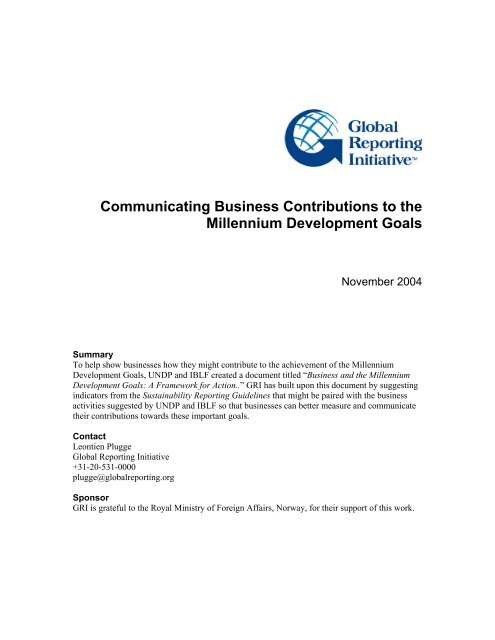

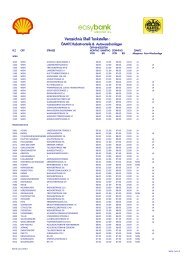
![Download Shell AutoGas Stationen [Stand: Januar 2013] (PDF](https://img.yumpu.com/9982753/1/190x245/download-shell-autogas-stationen-stand-januar-2013-pdf.jpg?quality=85)
